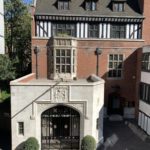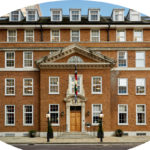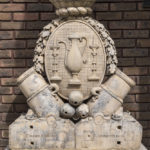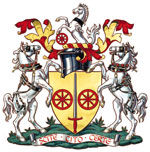Date/Time
Date(s) - Wednesday, June 15, 2022
11:00 am - 3:00 pm
Location
Various Livery Halls
Categories
This event is now FULL.
An informal, private visit to Ironmongers, Barber Surgeons and Founders Halls to see the internal treasures of these buildings followed by a delicious and bountiful Carvery lunch at Butchers Hall.
The cost is £65 per person and this includes a donation to our charities.
We have chosen four Livery buildings to delight you.
 Ironmongers Hall
Ironmongers Hall
The Ironmongers, who were originally known as the Ferroners, were incorporated under a Royal Charter in 1463. The Company’s original association with iron merchants, however, has lessened, especially due to the movement of the industry to the North, where iron ore has been more readily available. The Company today is primarily a charitable institution. The Company ranks tenth in the order of precedence of the City of London’s livery companies.
Ironmongers’ Hall is located in Aldersgate Street in the City of London. The first hall, dating back to 1457, was in Fenchurch Street; it was rebuilt in 1587 and rebuilt again in 1745 on the same site. The third hall was destroyed on 7 July 1917 by a bomb dropped during World War 1. The present Hall stands on land which was bought in 1922: construction work started that year and the Hall was opened on 17 June 1925.
 Barber Surgeons Hall
Barber Surgeons Hall
The first mention of the Barbers’ Company occurs in 1308 when Richard le Barbour was elected by the Court of Aldermen to keep order amongst his fellows. This Company also included surgeons amongst its number, the first recorded member appearing in 1312. Barbers and surgeons had overlapped in their duties for many years, largely because in the 13th century Pope Honorarius III had prohibited all persons in holy orders from practising medicine in any form.
Thus, barbers in the monasteries, already used to working with sharp blades, began to add minor surgical skills to their repertoire, which in due course were passed on to barbers elsewhere.
Since the 1440s the Barbers have had a Hall on the edge of the City in the area of the north-west corner of the Roman Fort of London. The first Hall was built in Monkwell Street In 1605 In 1636 the Court agreed that a new Parlour should be added, together with an anatomy theatre for lectures and demonstrations. The anatomy theatre was the only Company building to survive the Great Fire of London in 1666. The 2nd Hall was designed by Edward Jarman whose plan provided for a courtyard, with the main part of the Hall on its west side again using bastion 13 of the Roman wall
Hit on 24th August 1940 by the first incendiary bomb to fall on London and again on 29th December 1940 the Hall and surrounding area were totally destroyed by incendiary bombs which started fires that raged for three days.
Being without a hall for 29 years the Company opened their existing hall in 1969.
 Founders Hall
Founders Hall
The principal outward and visible sign that a City Company had “arrived ” was the possession of its own Hall. The Founders achieved this goal in 1531, when 18 members of the Company joined together to buy two houses and a garden in Lothbury and proceeded to build a Hall on a site that still bears the name of “Founders’ Court”. The Hall was completed in 1549.
The Hall, like so many others, was destroyed in the Great Fire of London in 1666 and rebuilt at a heavy cost mainly borne by the Liverymen from their own pockets.
In 1845 the Company built another Hall in Founders’ Court intended for its own purposes but owing to money constraints was leased.
The Founders’ Company then acquired freehold premises in St. Swithin’s Lane which was for many years partly let to various tenants as offices, but in 1966 it was entirely reoccupied by the Company and internally reconstructed.
In the early 1980’s, the Court took a decision to build a new Hall and during the period 1985 to 1987 a new building was erected on a freehold site at the east end of St. Bartholomew the Great in Cloth Fair.
The new Hall was designed by Sam Lloyd and the building much reflects his grandfather’s Arts and Crafts designs. Founders’ Hall was opened in September 1987.
 Butchers Hall
Butchers Hall
Tradition has it that in 975 AD in the Ward of Farringdon Without, there are “divers slaughterhouses and a Butchers’ Hall where the craftsmen meet,” – so begins an unbroken connection between the Butchers, a Butchers’ Hall and Smithfield. The Charter of Incorporation for The Worshipful Company of Butchers, was granted by James 1 in 1605.
Over the years Butchers Hall has had more than its fair share of ill fortune. Five of seven Halls were burned down including one that perished during the Great Fire of London in 1666.
The fourth Hall, in Pudding Lane, was subject to a compulsory purchase order in 1883 when it was demolished to make way for The Metropolitan District Line.
The new Hall in Bartholomew Court suffered considerable damage from a large bomb dropped from a Zeppelin in 1915 and again after a V1 bomb landed in the courtyard in July 1944.
Building work for the current Hall took about a year with funding from members of the Company and by companies and organisations involved in the meat industry at home and abroad.
The new Butchers’ Hall re-opened in September 2019 after a year’s major multi-million pound refurbishment and retains many of its features, finely balancing the traditions of a Livery Hall with first-class, modern facilities.
The traditional Carvery is highly sought after, but we have managed to secure places for Carmen and guests on one of their few dates, Wednesday 15 June.
This will be a popular event so early booking is recommended. Please book using the form below. The deadline day for booking is Wednesday 1 June 2022. Please email social@thecarmen.co.uk if you have any queries.
